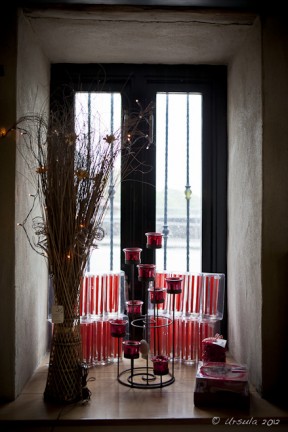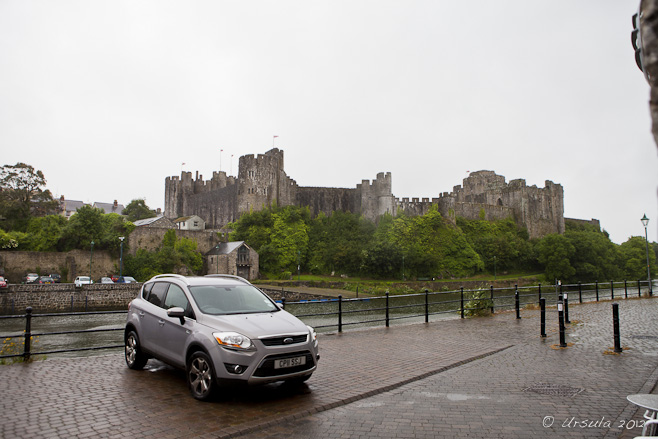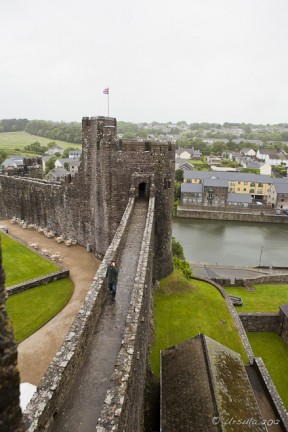
The Cornstore
We had coffee and took refuge from the pounding rains.
I guess that rainy weather is pretty common in Wales.
One clue is the council workers: as we walked from Pembroke Dock to Pembroke, splashing through puddles that wet us up to the knees, huddling under raincoats that whipped in the wind, and clinging to umbrellas that turned inside out and failed to keep the rain off our faces, we watched one man on a ride-on mower cutting the grass on the verge of the road, while another was using a whipper-snipper along the edges.
I couldn’t believe they were out working in such weather – unless, of course, they had no expectation that it would ever improve!
I suppose they had a schedule to keep, rain or no rain, and – as we had only one day before sailing to Ireland – so did we.
Although the walk from our lodgings to the Mill Pond, over which Pembroke Castle sits, took less than an hour, we were wet through and happy to find the charming Quayside Café at The Cornstore. Dripping, we drank steaming coffee before trying to time our dash across the river.

Pembroke Castle
A wet view across the River Cleddau from the Cornstore Cafe.
At the gift shop next to the ticket office, we purchased an oversized umbrella with a Welsh dragon on it, hoping that it would protect us from the elements. We then entered the barbican before climbing up tower steps to walk along the wall and look out over the city.

Walkway over the battlements.

A view over wet Pembroke streets.

The rains make sure that the surrounds are very green!

Through the Window…
Pembroke Castle has been extensively developed and restored over the ages. Historians believe the site has been occupied for 12,000 years; examples of tools used by cave dwellers during the Palaeolithic Period have been found in the Wogan – or cavern – deep in the rock under the castle. Late Bronze Age tools and Roman coins have been found nearby. It is thought that the first fort was built on the promontory during the Iron Age.
Then, the early Norman invaders installed themselves in West Wales, and Roger de Montgomery established his headquarters in a wooden castle at Pembroke from 1093. The buildings, in various forms, survived a number of reigns, becoming “the birthplace of the Tudor dynasty” when Henry VII (father of Henry VIII, grandfather of Elizabeth I) was born in a tower there in 1457. The castle changed hands and allegiances a number of times, being partially dismantled after its role in an ill-fated rebellion in 1648, before falling into ruins.
From the 1880’s until present, the castle has been extensively restored – some say to such an extent that it has become almost sterile. Although it is open to the public, it remains in private hands.

Contrasts
The Red Dragon, symbol of victory over the Saxons, was adopted by Henry VII: he wanted to demonstrate his claim to descent from the earliest British Kings. Today it provides an interesting contrast against the power lines on the hill in the background.

Steeped in damp and dark, the various rooms have posters detailing castle history.

Dinner in the Gatehouse
A tableau depicting a feast at the table of William de Valence, 1st Earl of Pembroke (c. 1225–1296).

Window
Deeply inset stone windows (c. 1300s) afford protection, but let in little light.

Doorway
Looking out over the slippery, wet ramparts between towers.

Castle Tower
To balance the Welsh dragon, a Union Jack flies high against a wet grey sky.

The Outer Curtain Wall
Doubled in thickness during the Civil War of 1642-45, these wet walls lead up to the Henry VII Tower.

Monkton Tower
Constructed in the mid 13th Century.

Archways
Looking through the remains of the restored Medieval Chancery (a medieval writing office).

Weeds and Moss
Green weeds and yellow fungus cling to the medieval stonework.

Halls
Entries to the Northern Hall and the Norman Hall: dating back to Richard Strongbow (c. 1150-70).

Northern Hall
There is little respite from the rain in the roofless rooms…

William Marshal’s Great Tower
The wet lawns inside the castle walls are quiet: there are not many visitors today.
The castle isn’t really up to tours in the wet, so it was no surprise that there weren’t many other visitors. Slippery steps prevented us from making the descent into the wogan watergate. Winds on the ramparts tore our newly-bought umbrella to shreds.
 But, we learned a lot about political scandal, conflict and the Tudor family ~ all things I might have learned at school, but had long since forgotten…
But, we learned a lot about political scandal, conflict and the Tudor family ~ all things I might have learned at school, but had long since forgotten…
History is much more fun in a castle – even in the rain.
Pictures: 15 June 2012






















.png)


I will never forget the look of the umbrella. What a tangles mess it was.
it’s raining, but a interesting series. Greetings Dietmut
It was, indeed, wet and windy!
Thanks for the visits, Dietmut and Gabe. 🙂
Fantastic, what history, WOW… that said that one one hell of a window seat, all seat no window…magnificent all in all.
Too true, Signe – the lighting in these places is “diffused” to say the least! 😉